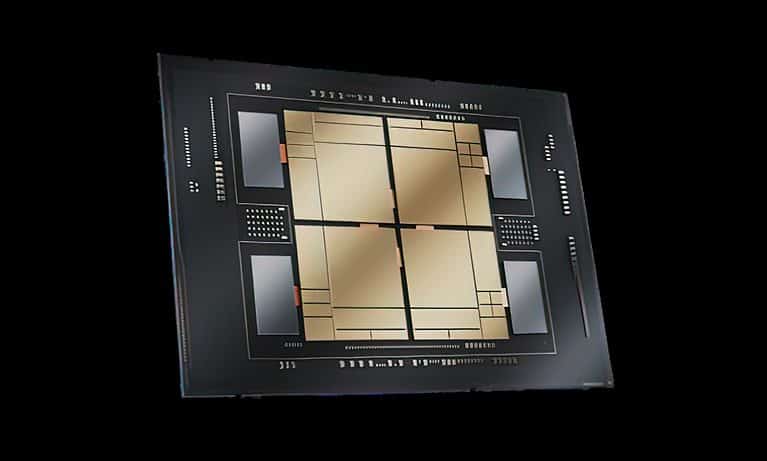Intel’s new server and high-performance CPUs are available. The chip manufacturer claims that the Sapphire Rapids series performs faster and more energy-efficient than Ice Lake, its former flagship. In addition, Intel launched Ponte Vecchio, a series of GPUs for high-performance computing.
The series suffered several delays. Sapphire Rapids processors were initially scheduled to become available in 2021, but the launch was postponed to 2022. In November, Intel brought bad news once more. 2022 proved unrealistic. The deadline shifted to January 10, 2023.
The question remained whether the chip giant would succeed this time around. Meanwhile, we have an answer. The Sapphire Rapids, Sapphire Rapids HBM and Ponte Vecchio series are now available.
The Sapphire Rapids series (4th Gen Intel Xeon Scalable) consists of CPUs for servers and workstations. The Sapphire Rapids HBM series (Intel Xeon CPU Max) consists of CPUs for high-performance computing. Lastly, the Ponte Vecchio series (Intel Data Center GPU Max) consists of GPUs for high-performance computing.
Sapphire Rapids
The Sapphire Rapids series will catch the attention of most customers. This is Intel’s new flagship for datacenter servers, one of the firm’s most important markets. The previous generation (3rd Gen Intel Xeon Scalable) is known as Ice Lake, a popular series among public cloud providers and private cloud operators.
Intel promised that Sapphire Rapids processors perform faster and more energy-efficient than Ice Lake — more on that later. It hopes to convince users of Ice Lake processors to upgrade to Sapphire Rapids. That’s quite the challenge in a competitive market.
In November 2022, AMD unveiled the fourth generation of its Epyc series, also known as ‘Genoa’. The processors compete directly with Intel’s Sapphire Rapids series. AMD Milan, the third generation of the Epyc series, is one of Intel Ice Lake’s biggest rivals. The competitors continuously fight for market share.
Back in mid-2022, AMD was on the winning side. Research by Cockroach Labs suggested that AMD Genoa processors were more cost-effective than Intel Ice Lake in many situations. Intel wants to turn the tide with the Sapphire Rapids series. The question is whether it will succeed.
Benchmark
Intel promised that Sapphire Rapids processors deliver up to 2.9 times more performance per watt than Ice Lake processors. AMD promised that Genoa processors perform up to two times better than Milan processors.
Vendor benchmarks tend to be optimistic. Hence, we pulled up one of the first analyst reviews. Michael Larabel, founder of technology website Phoronix.com, received the Intel Xeon Platinum 8490H for a test drive. The Intel Xeon Platinum 8490H is one of the fastest processors in the new series.
Larabel reviewed the model using different workloads over a period of one week. The analyst acknowledges that a week is far too short for a definitive conclusion. Nevertheless, the results give an impression of the series’ performance. For most of the workloads tested, the Sapphire Rapids processor performed about twice as well as its Ice Lake predecessor (Xeon Platinum 8380).
Intel promised performance improvements of up to 290 percent. Larabel ended up with a lower figure, but that doesn’t mean Intel is lying. The new processors perform best when used in conjunction with accelerators for specific workloads, which we’ll cover later in this article. Larabel did not review accelerators due to a lack of time.
Despite the performance increase, Intel lost to the AMD EPYC 9554 (one of the fastest AMD Genoa models) in most categories. The differences in performance weren’t major, though pricing is a different story. The Intel Xeon Platinum 8490H has a recommended US retail price of $17,000 (about €15,800). The AMD EPYC 9554 comes in at just over $9,000.
Sapphire Rapids HBM and Ponte Vecchio
In addition to Sapphire Rapids, Intel launched a processor series for high-performance computing dubbed Sapphire Rapids HBM. According to Intel, the new processors perform up to 3.7 times better than comparable processors in the Ice Lake series.
The models have the highest density of any processor in Intel’s offerings. “Sapphire Rapids HBM is the first and only x86-based series with high bandwidth memory, accelerating many HPC workloads without the need for code changes”, the organization said.
In addition, Intel launched the Ponte Vecchio series, a range of GPUs for high-performance computing. Back in August 2022, Intel claimed that Ponte Vecchio processors outperformed Nvidia A100 processors (a similar series) by 2.5 times.
Accelerators and Intel On Demand
The performance improvements of the Sapphire Rapids and Sapphire Rapids HBM processors are made possible by accelerators. Accelerators are integrated software programs that optimize a processor for a given workload.
The new processor series feature ten integrated accelerators, including Intel Advanced Matrix Extensions (AMX). According to Intel, the accelerator improves the performance of processors used to train deep learning models. Common applications include natural language processing and image recognition.
Another example is Intel Crypto Acceleration, an accelerator for encryption workloads in SSL servers and firewalls. Furthermore, there’s the Intel Data Streaming Accelerator (DSA), which accelerates data transfers between the CPU, memory and caches to speed up data-intensive workloads. The availability of accelerators varies by processor model.
Lastly, Sapphire Rapids processors are the first processors to feature Intel’s new On Demand licensing service. The licensing service gates some processor features behind a paywall. Customers can purchase features such as accelerators during or after the purchase of a processor.
